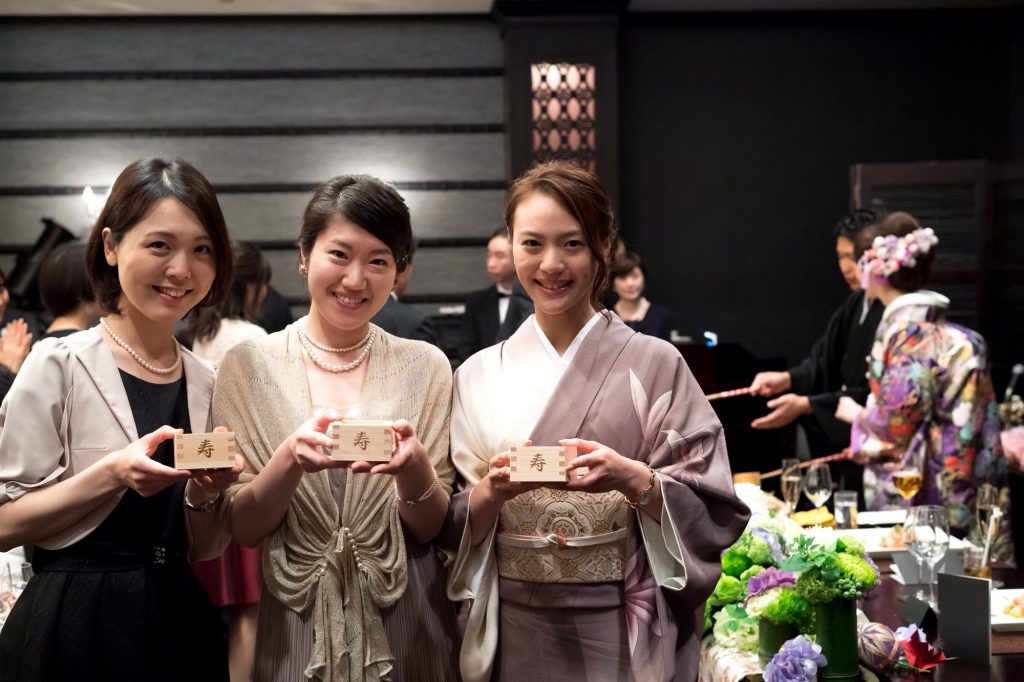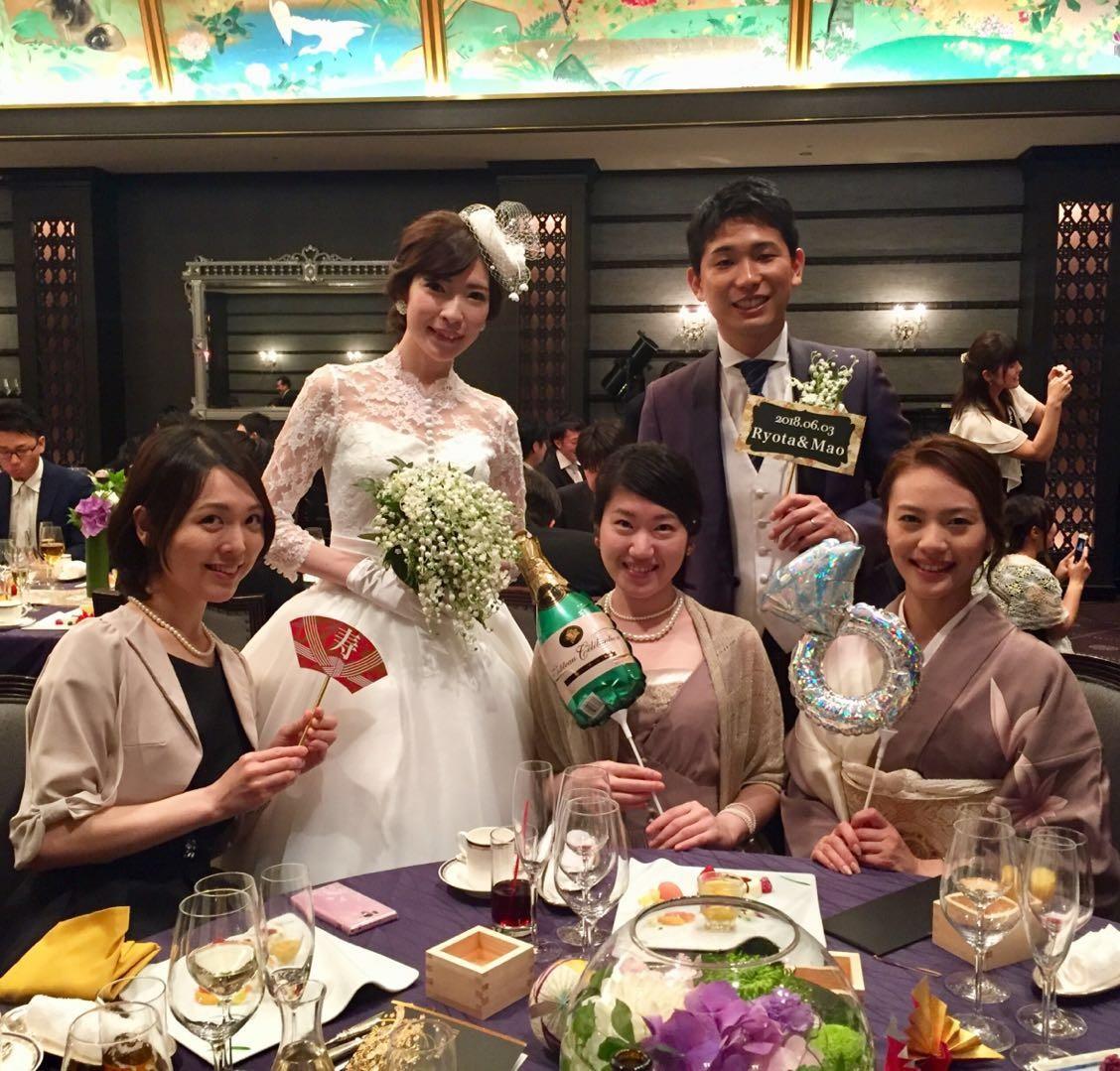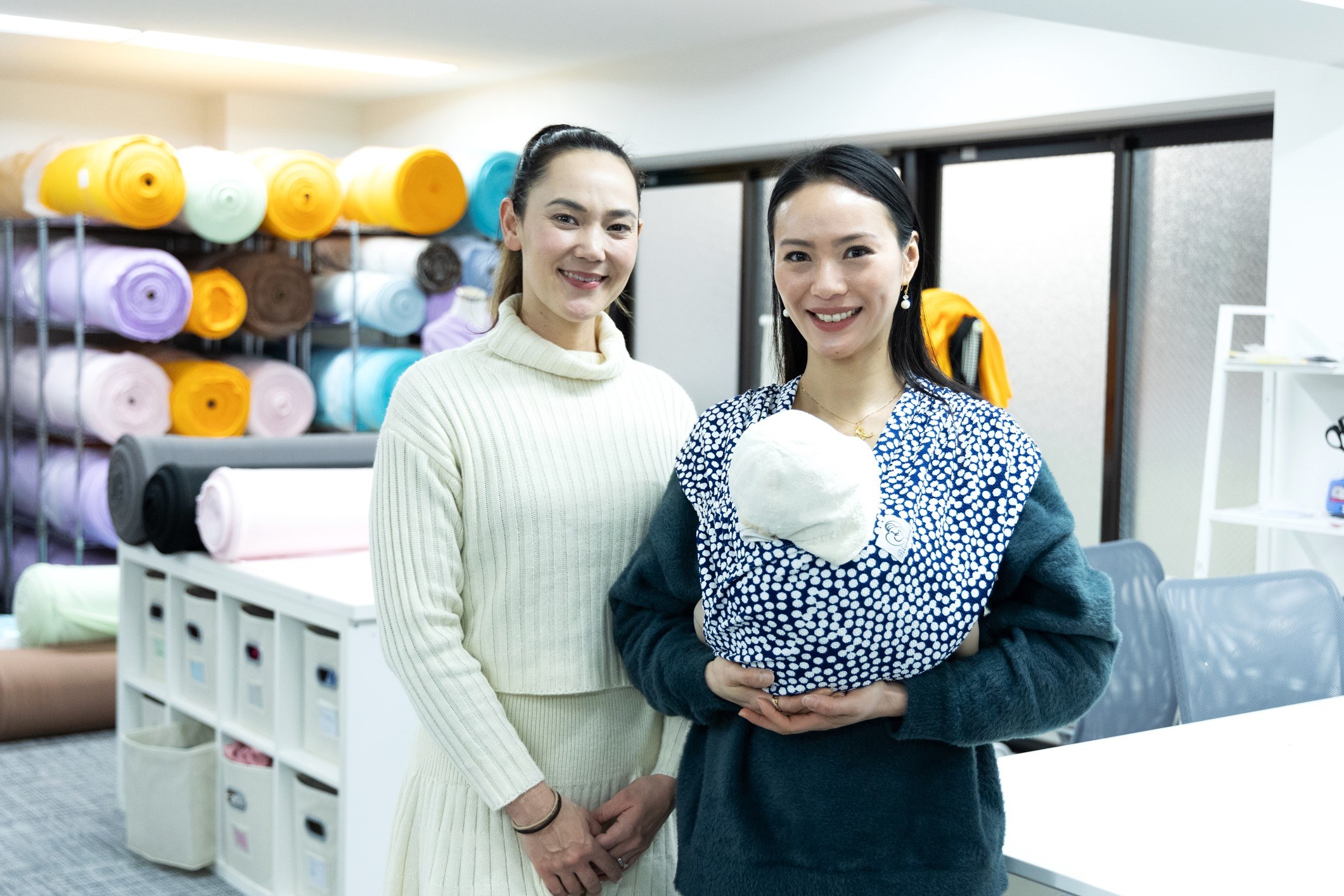I was so happy to receive my first invitation to a Japanese wedding just over a month ago. The bride: Mao Miyake-san, one of the ladies who had participated in the Oiran Dochu parade together with me last year. (For those who have not read about my experience as an Oiran, click HERE for my previous blog post!)
私は6月に初めて日本の結婚式に招待されたことをとても嬉しく思います。 花嫁は去年私と一緒に花魁道中に参加した女性の一人、三宅真央さん。(花魁土中のニュースについて、まだ読んでいない方は、ぜひリンクをクリックしてご覧ください~)
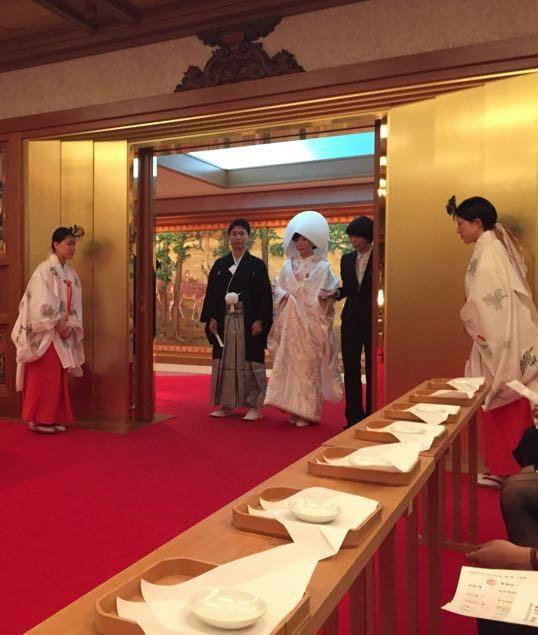
Congratulations to the newlyweds, Ryota Noguchi and Mao Miyake!
新婚夫婦野口亮太さんと三宅真央さん、おめでとうございます!
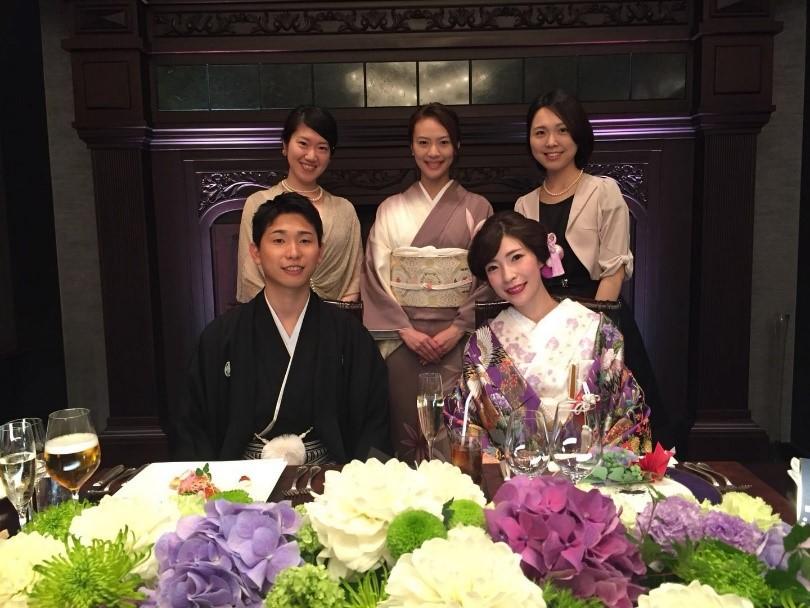
Two other Oiran Dochu parade participants (Miss Fukuda and Miss Oshima) also attended the wedding ^^
花魁道中の他の2人の参加者(福田さんと大島さん)も結婚式に出席しました^^
It was my first time to attend a Shinto wedding ceremony and celebrate this special moment with the wedding couple. The Shinto ceremony was spectacular with unique customs and costumes just for the occasion, complete with detailed proceedings so guests can follow along with what is going on.
神前結婚式の出席は初めてのことでした。 とても素晴らしい儀式でした!
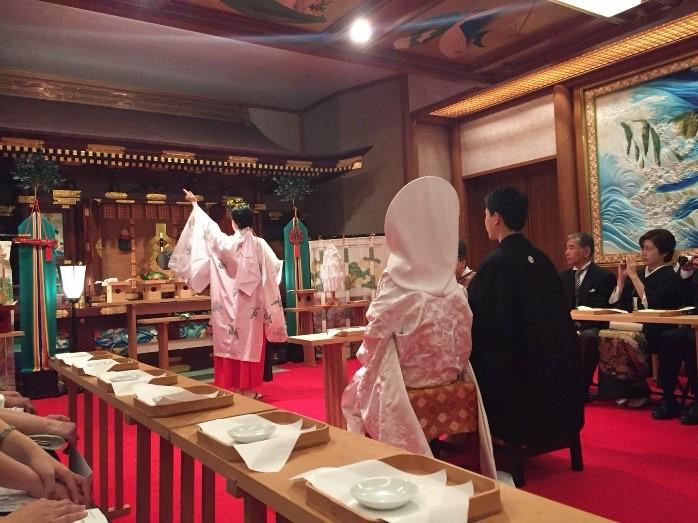
神楽舞
Kaguramai (Dedication of Sacred Dance): A Shinto maiden dedicates a sacred dance.
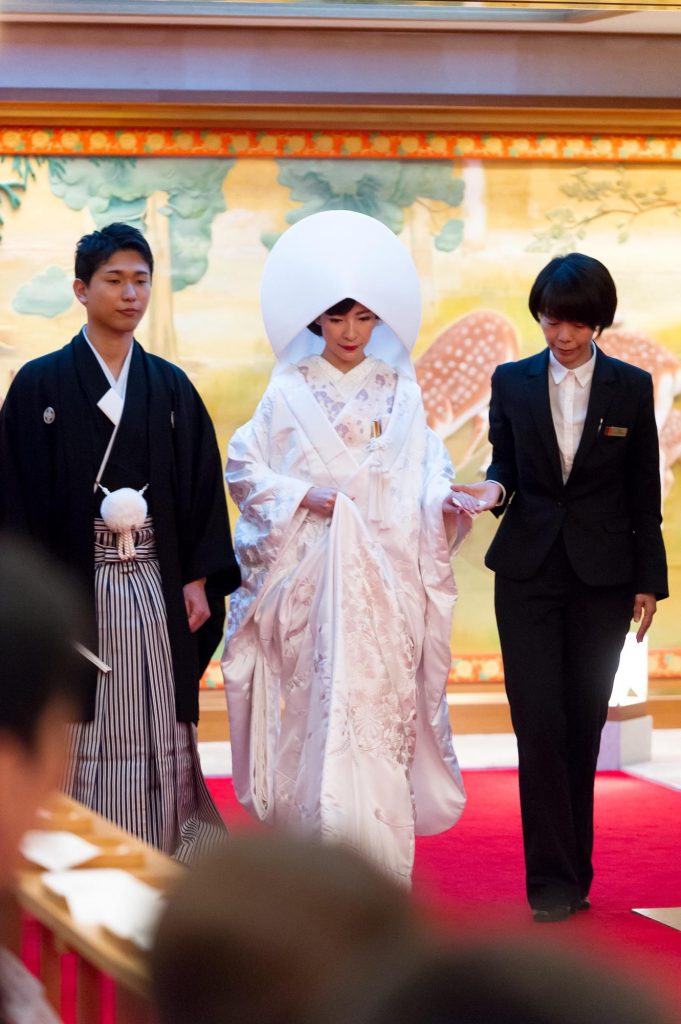
For Shinto weddings, the bride usually wears a shiromuku – an all-white kimono – for the ceremony. The white hood, which is called wataboshi and is similar to a western bride’s veil, covers the hair and most of the face. White symbolizes purity, and the willingness of the bride to be “painted” by her new family upon marriage. After the wedding ceremony, the bride changes to a luxurious kimono with colorful patterns (irouchikake) for the wedding reception (hirou-en). This change in color represents the bride having been “painted” after marriage, and brings prosperity to both families.
神前式で真央さんが着ていた着物は、『白無垢(しろむく)』という種類です。昔は様々な式典や儀式に用いられてきました。白には「清らかな身と気持ちで式を迎え、嫁いだ先の色に染まる」という意味も込められていました。挙式後の披露宴では色打掛(いろうちかけ)に着替えることがありますが、これは「挙式後に、嫁いだ先の色に染まった」ことや「豪華な文様で花嫁の旅立ちと両家の繁栄を願う」ことを示すとされてきました。
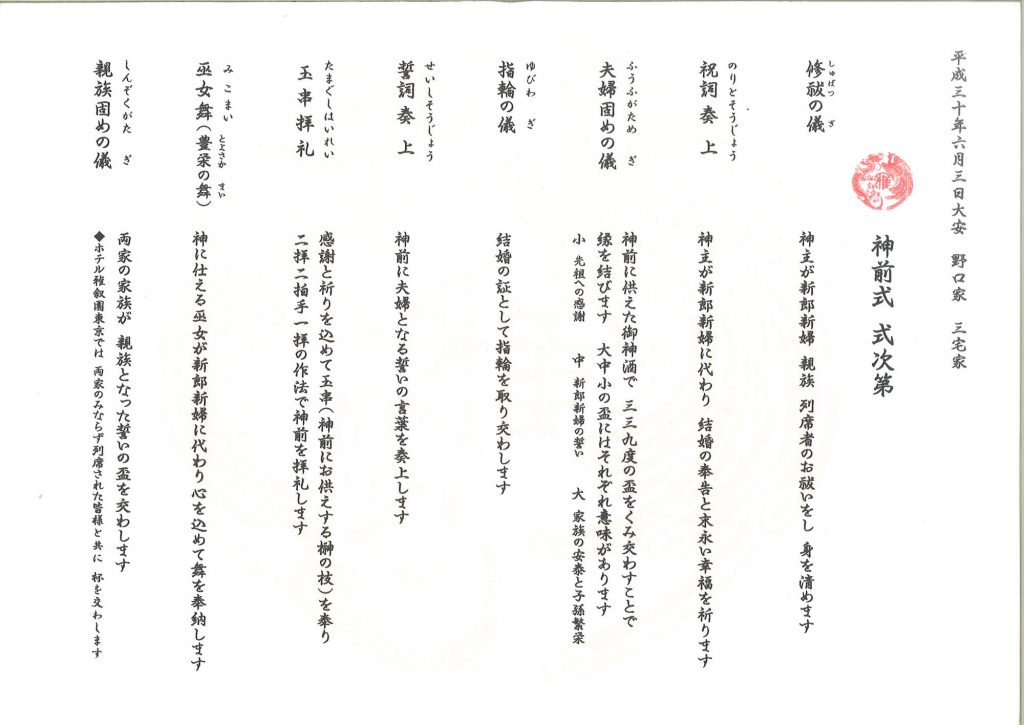
神前式の式次第
Agenda for the Shinto ceremony. Click here for English information,
As with many things in Japan though, wedding functions come with their own unique set of rules, and are quite different from Western style weddings! Here are some reflections on my experience (and tips for those of you who have the chance to attend a Japanese wedding in the future)!
ちなみに、日本の結婚式は西洋式の結婚式とはまったく異なります!面白いのでいくつか紹介します。
- Invitations: Whereas funny notes and web/email invites have become trendy for young couples tying the knot in the West, do not expect this in Japan. If you are invited to a wedding, you will receive a very formal invitation letter sent by mail (in my case, an elaborately decorated card). Also, no matter if you attend the wedding or not, you are expected to send a *written* answer. You will likely find a card along with your invitation, which requests you to confirm your presence or absence and *mail* back ASAP.
- 招待状:日本の結婚式招待状はとてもフォーマルです。 西洋の結婚式のような楽しくアレンジした面白いカードや電子メールの招待状はありません。 また、結婚式に出席するかどうかに関わらず、必ず書面による返信をしなければなりません。
- Gift Money: Guests are expected to give money (not presents) to the newlyweds. This is actually common for Chinese weddings as well, but the whole concept of goshugi (gift money) deeply rooted in Japanese culture may be quite surprising to foreigners.
- ご祝儀:出席した人は、本人達にWedding Giftではなく、お金を贈ります。 この習慣は中国の結婚式にも共通していますが、日本文化に深く根ざしているご祝儀のコンセプトは、外国人にとっては、驚くかもしれません。
ちなみに、“ご祝儀貧乏“という言葉は、外国人にとって興味深い概念と思います~
“Gift Money Poor Person”: Many of us may be familiar with the notion of spending a good amount of money on attending weddings, which tend to congregate at the same time, but the Japanese actually have an apt word to describe this status! When the wedding season starts many people turn into “goshugi-binbo,” literally referring to someone who has become “a poor person” from attending too many weddings (and paying gift money).
- Envelopes: As soon as you send off your notice of attendance, visit a stationary store and buy a goshugi-bukuro – similar to the custom of red packets in Chinese culture, these are special envelopes that you need to use for gift money. They can easily recognized by the colorful designs, usually bearing the kanji for celebration (御祝 or 寿). Always buy the most colorful envelope, and remember to get one with the ribbon going upwards for weddings! Do not forget to your name on the front of the goshugi-fukuro, along with your address and name inside the white envelope and the amount of cash you’ve included.
- ご祝儀袋:この習慣は西洋の結婚式にはありません。結婚式のために、どのような祝儀袋を使うべきかは、外国人にとって、本当に困りますね。(ヒント:リボンを上に向けて最もカラフルなものを選んでください!)

- Wedding Favors: Wedding couples will give the guests substantial gifts, a tradition called hikidemono. This is usually a gift bag placed on your seat, from the newlyweds and their families to express their gratitude for the guest’s attendance on their big day. Since these bags full of gifts can be very heavy, guests can even choose from a catalogue and pick their desired gift to be delivered home directly.
- 引き出物:新婚カップルから返礼として豪華な贈り物を頂くのは、西洋の結婚式の習慣にはありません。私は様々な贈り物に驚きました!特にカタログの贈り物はとても便利ですね!!
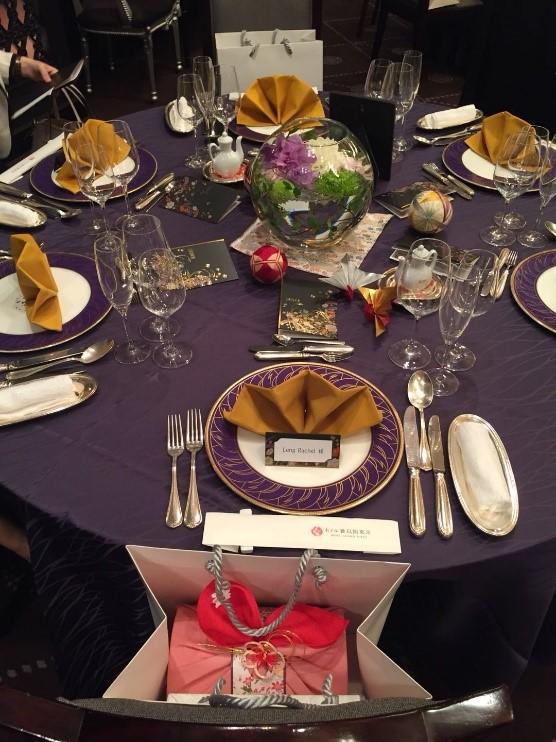
My gift from the wedding couple and their families.
私が頂いた引き出物です~ 本当に感謝しています!
- Seating arrangements: bosses and colleagues sit closest to the couple, not family or close friends (who are seated at the far end of the room). This is pretty much opposite to a Western wedding!
- 座席の順番:上司や同僚が新婚カップルに最も近い場所に座ります。家族は一番遠いところに座って、西洋人には奇妙に思うかもしれません…
- Dress Code: In contrast to Western weddings where guests tend to dress in colorful clothes to celebrate the happy occasion, Japanese weddings require muted colors.
- ドレスコード:洋風の結婚式では、華やかな服を着て楽しむ傾向がありますが、日本の結婚式では黒がフォーマルのカラーなので、控えめな色合いが必要だそうです。
Men should wear a dark suit with a WHITE tie (“Black Tie” formal dress in the Western style would be for attending funerals).
男性は白いネクタイで黒い服を着用してください(洋服の“Black Tie”フォーマルドレスは、葬儀に出席するためのものになるそうですので、注意が必要ですね)。
Women should wear conservative (i.e., usually plain black or brown) dresses (avoiding white at all costs) with stockings. Shoulders should not be exposed.
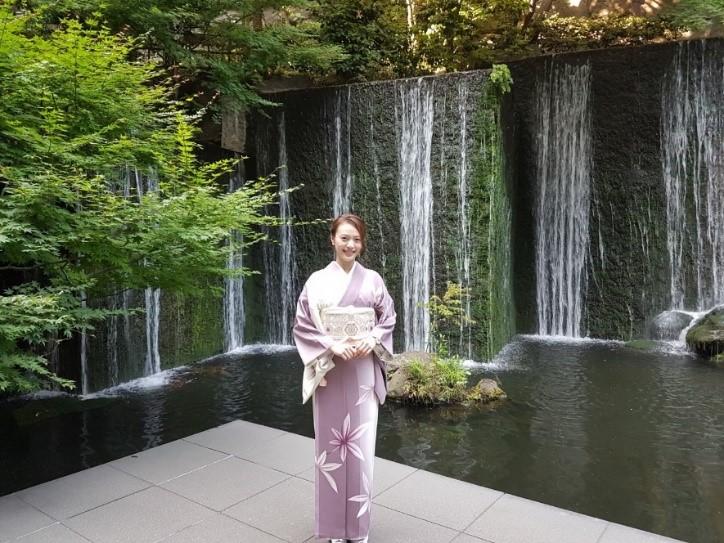
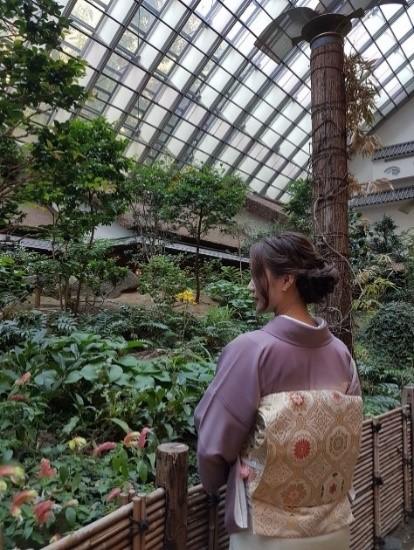
As I was attending a Shinto wedding for the first time, I did not want to risk making a dress code mistake and decided to rent a kimono. There are even rules for the kinds of kimono that you are allowed to wear (i.e., Furisode (kimono with long sleeves) for unmarried women or homongi (kimono in plain colours with short sleeves) for married ones)! However, if you tell the kimono store that you are attending a wedding, they will be sure to dress you in the appropriate style.
私は初めて日本の結婚式に出席したので、ドレスコードの間違いを犯したくないために、着物を借りることに決めました。 でも、結婚式の場合は、特別な着物もありますね!私は全然わからなかったので、呉服屋の店員から教えてもらってよかったです。
- Wedding dates: Unlike their European counterparts, Japanese couples don’t get sentimental over dates, but choose a wedding date based on rokuyo (calendar notes that are supposed to tell the daily fortune).
- 結婚式の日程:欧米では、自分にとっての思い出の日(例えば、2人が初めて会った日などで)日取りを決めますが、日本人はいつも「六曜」に基づいて、結婚式の日取りを決めますね。
- Guests: Unlike in the West where it is commonplace to bring a +1 to a wedding, regardless whether one is married or not, guests to Japanese weddings will be invited alone. (And it is considered rude to request bringing another guest.)
- ゲスト:欧米で結婚しているかどうかに関わらず、結婚式に+1人を付けることが当然の文化がありますが、日本の結婚式のゲストはその招待状を頂いた本人一人だけで招待されます。
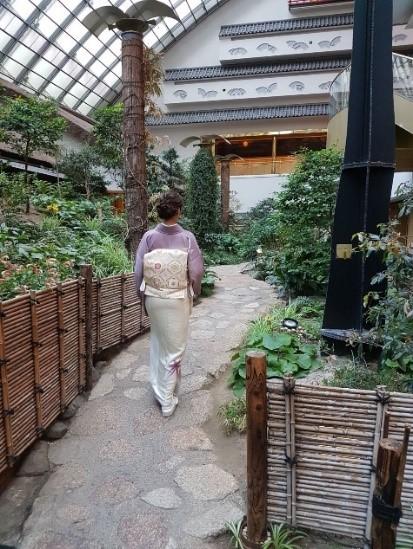
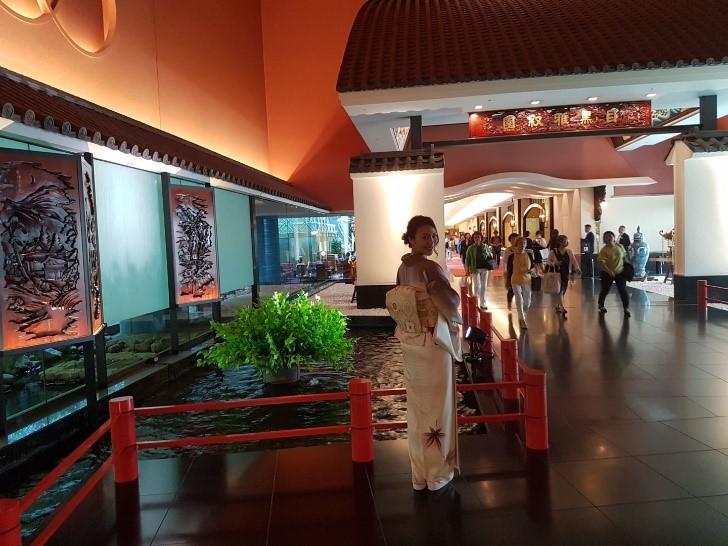
Attending the wedding reception at Hotel Gajoen Tokyo alone.
一人で『ホテル雅叙園東京』の結婚式に出席しました~ とても綺麗で、伝統的なホテルでした!
※宮崎駿監督の『千と千尋の神隠し』に出てくる、湯屋のモデルになった場所です ^^
- Everything is planned: There is no such thing as impromptu in a Japanese wedding. Furthermore, although a huge cask of sake (taruzake) is opened and shared with all guests during the wedding party (hirou-en), the drunken revelry and dancing of most Western weddings is absent. The ceremony and reception starts on time and ends promptly after about two hours.
- すべては時間通りに予定されている:日本の結婚式には即興のようなものはないですね。 さらに、披露宴では、巨大な樽酒が開かれ (『鏡開き(Kagamibiraki)』という儀式)、皆で飲みますが、西洋式結婚式のように酔っ払っていて、喋ったり踊ったりの雰囲気はあまりないですね。 結婚式と披露宴は時間通りに始まり、約2時間後にすぐに終了して、ちょっとびっくりしました。>.<;
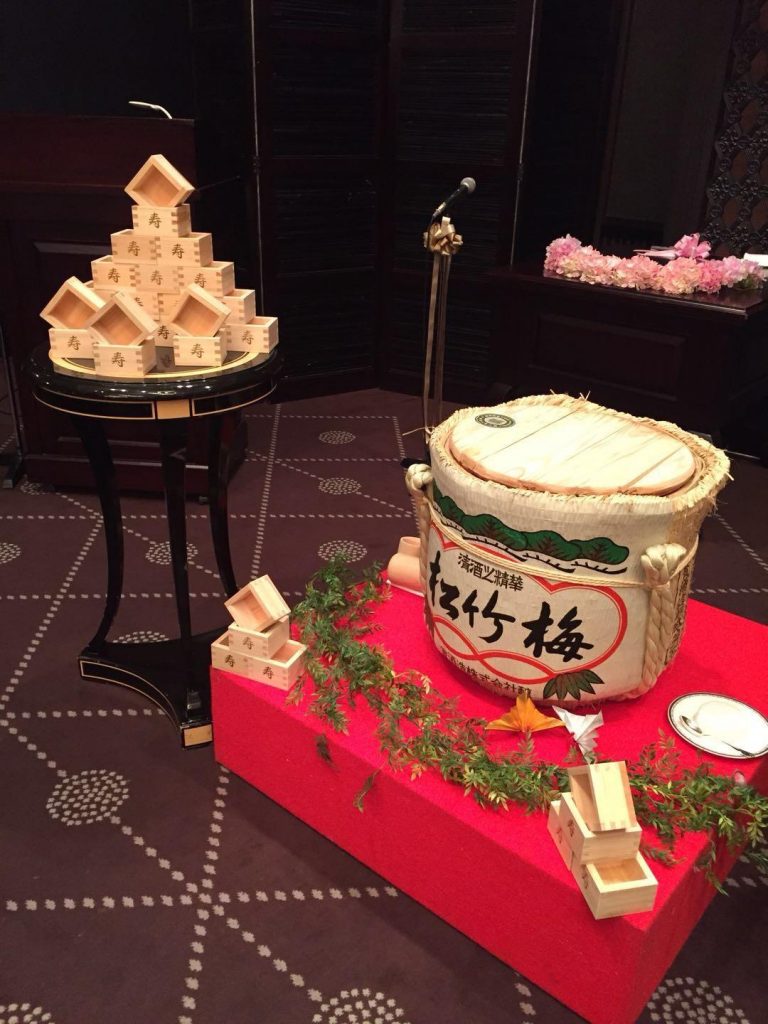
A large cask of taruzake to be opened for the wedding reception and shared with all guests (a ceremony called Kagamibiraki).
樽酒は『鏡開き(Kagamibiraki)』という儀式です.
樽酒を頂きました!Receiving taruzake from the bride, Mao-san, in a luxurious purple kimono (irouchikake) after the wedding ceremony ~

You drink the taruzake from a fragrant hinoki (Japanese Cypress) wood sake box (called masu)! The fragrance of the wood combines with the sake to create a distinct flavour.
木曽ひのきの酒器から日本酒を飲みました。木の香りがお酒に移ってソフトな口あたりになります。手の中には木のぬくもりとほのかな香りが漂う贅沢さが魅力です。
